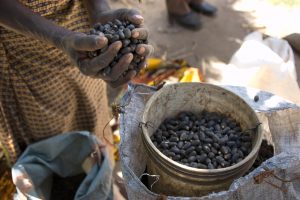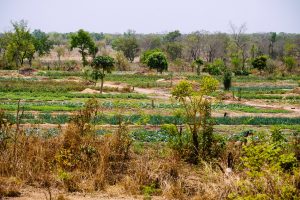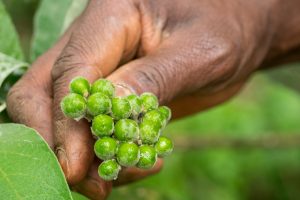“Essential.” “Obvious.” “The model of the future.”
Last month, when more than 1,200 scientists and experts met at the World Agroforestry Congress in France, agroforestry was praised for its multitude of benefits. It was lauded as a solution to many of the world’s most pressing challenges, including poverty, malnutrition, climate change, biodiversity loss, migration and conflict.
But, if agroforestry is so great, why isn’t everyone doing it?
One tomato, two tomato, three thousand tree tomatoes
When trees and crops are successfully farmed together, agroforestry does provide a wealth of environmental, social and economic benefits. This is the case in Bugesera district in Rwanda, where 2,000 farmers have started growing tree tomato, which is a result of a scaling-out initiative of the “Trees for Food Security” project funded by the Australian Centre for International Agricultural Research (ACIAR) and led by World Agroforestry (ICRAF), a partner of the CGIAR Research Program on Forests, Trees and Agroforestry (FTA).

The project seeks to introduce tree tomato to Bugesera district and enhance production in Musanze and Nyabihu districts in Rwanda, in both humid and drier contexts. It has also established rural resource centers (RRCs), which are hubs for the supply of quality germplasm, and training and peer learning.
These fast-growing, small, shrubby trees produce fruits (popularly known as “Tamarillo”) that are rich in nutrients, particularly vitamin C and A. They fill an important gap in local diets. In Rwanda, 38 percent of children below the age of five suffer stunting as a result of malnutrition.
“The beauty of growing tree tomato is that jobless people – who seemingly had no future – are now given a source of income and livelihood,” said Catherine Muthuri, senior scientist with ICRAF and Trees for Food Security project manager.
“A farmer will say, ‘this is good – I’m not going anywhere, I just harvest it right outside my house and then someone comes and buys it.’”
According to farmers’ testimonies, they use the proceeds from tree tomato sales to pay for school fees and health insurance, and to buy clothes. They also use the funds to renovate their houses and open accounts in the local bank – Sacco. They also consume the product at home to reduce malnutrition.
The RRCs are key to the development of satellite nurseries, that are run by cooperatives or farmer groups to provide farmers various high-quality tree seedlings that, along with proper management techniques, translate into bigger benefits for farmers. This, in turn, increases the incentive for farmers to plant many more trees in the future, benefiting soil health, increasing carbon storage, controlling soil erosion and providing diverse products like fruit (such as tree tomato, mango and avocado), fuel, timber, fodder and fertilizer.
Read also: The right species for the right purpose
A recipe for success
“Once you convince a farmer that there is something in it for them and that their values, interests and their experiences matter, they will then allow you to support them,” said Muthuri. “At the end of the day, it’s their farm where the project is trying out these technologies.”
This close collaboration, according to Tony Bartlett of ACIAR, is one of the likely reasons why this project has been successful in scaling its innovations. The Ethiopian government recently announced its plans to transform 30,000 agricultural extension centers based on the RRC model, and nursery cooperatives are taking off in Rwanda and Uganda.
When Bartlett reviewed 15 ACIAR-funded agroforestry projects, he found the Trees for Food Security project to be among the top three most successful.

“I’m a firm believer that the market part is critical because it becomes a ‘pulling’ factor. If the development is going in the wrong direction, then consumers or governments can correct it, but the market is the driving force,” said Bartlett.
In Bugesera district, farmers have been eager to grow tree tomato precisely because of a strong market demand. Soon, farmers and scientists will start exploring opportunities to process the tree tomato fruits, hoping to add value and ensure that returns remain high. At the same time, the Rwandan government’s commitments to improving nutrition and restoring land have provided prime enabling conditions.
However, large-scale uptake of agroforestry is still rare. Because, according to Bartlett, transformation at the country or industry level is complicated. “The trouble is, there are infinite combinations of trees and crops that can be grown together,” he said. Local agroecology, policies and markets all play a role in determining what can work where.
Still, Bartlett proposed that research institutions share agroforestry solutions with those who can implement them, whether they are development partners or private sector actors. He pointed out that the cocoa or coffee industries are actively looking to produce in more sustainable ways, thanks to growing consumer awareness.
“What the research-for-development community hasn’t done well is sharing our best-bet options at a relatively early stage. We wait too long,” he said.
Read also: Trees nurture nutrition
Next stop: The global development agenda
FTA Director Vincent Gitz, from CIFOR, projected this same sense of urgency as he delivered one of the final keynote presentations of the World Agroforestry Congress.
“Precisely now, as we’re reaching 2020, we have to proceed with the implementation of the Paris Agreement and the Sustainable Development Goals,” he said. “And these commitments all mention trees and agroforestry, but nothing much about exactly what it takes – what tree species, what techniques, what business models or what enabling policies.”

Gitz urged his colleagues to bring forth the evidence that can be used to inform national policies and achieve global commitments. “In FTA, we consider it our role to influence the farm–forest policy interface at the national level, as this is where we can unlock some of the barriers to scaling agroforestry,” Gitz said. “At the international policy level, we cannot do it alone, but there are ways in which we can influence the discussions.”
He highlighted the process to define the post-2020 framework for the Convention on Biological Diversity, countries’ efforts to achieve their nationally determined contributions under the UN Framework Convention on Climate Change, and the UN Committee on World Food Security’s 46th session later this year as major opportunities for integrating agroforestry into the global development agenda. Unfortunately, as Gitz said, “the world lacks a universally agreed definition of agroforestry. And without an agreed definition, it’s difficult to get policy integration. So, this should be a first step.”
As the congress drew to a close, the participants agreed to a statement calling on world leaders to promote the benefits of agroforestry to land owners and managers across the globe. Only when farmers everywhere can enjoy benefits similar to those emerging in Bugesera district in Rwanda will agroforestry truly have become a model for sustainable development.
Now is the time to turn from aspiration to action.
By Marianne Gadeberg, communications specialist.
The CGIAR Research Program on Forests, Trees and Agroforestry (FTA) is the world’s largest research for development program to enhance the role of forests, trees and agroforestry in sustainable development and food security and to address climate change. CIFOR leads FTA in partnership with Bioversity International, CATIE, CIRAD, ICRAF, INBAR and TBI. FTA’s work is supported by the CGIAR Trust Fund.











